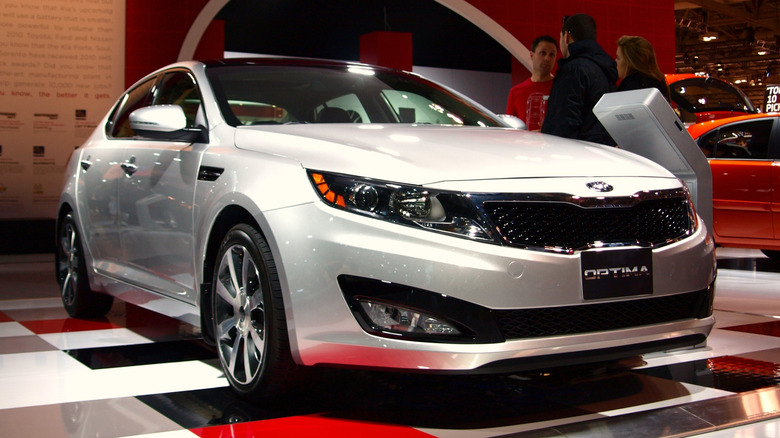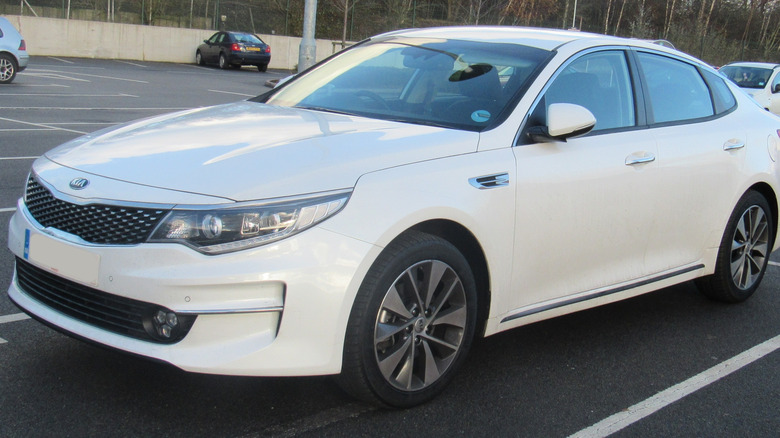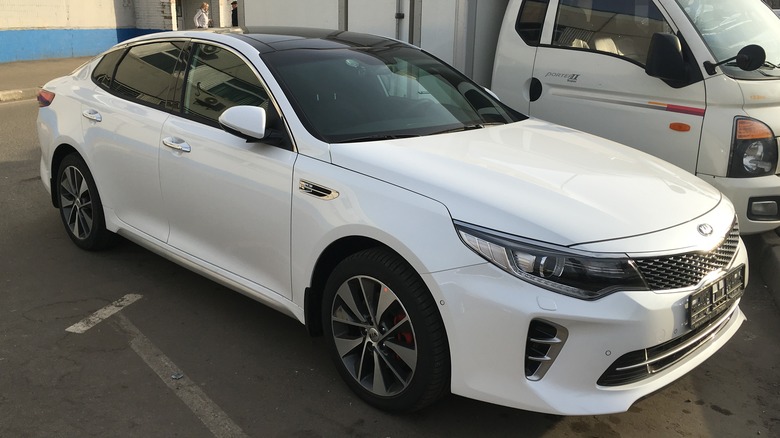These Are The Kia Optima Model Years Owners Say You Should Avoid
The Kia Optima debuted in 2001, after the Kia Sportage, and has long been one of the most successful models in Kia's history. However, if you were to go over to the Kia website right now and browse its current selections, you would not see the Optima as an option. That is because the company decided to rename the vehicle to the K5 a few years ago, although it is still very much the same sedan that it has been for the past quarter of a century.
A car lasting as long as this one has, especially after a name change, shows that there are quite a lot of fans of what this machine can do. This longevity probably leads a good number of people to seek out a Kia Optima on the used marketplace. However, as is the case with any car with a lifespan as long as the Optima, there have been many peaks and valleys over the many model years.
Some years have sterling performance and reliability records, while others have more complaints made against them than any vehicle would wish to have. Here, we are going to focus on those bad years with a large number of owner complaints, based on data from the National Highway Traffic Safety Administration (NHTSA) and CarComplaints. These are the model years that should not be in your garage.
Avoid all third generation Optima models
Every few years, car companies overhaul their vehicles to keep up with modern technologies and aesthetics. The Kia Optima has had five generations in total, with the fifth being when it was rebranded as the K5. Most of these generations have an average or even below-average number of complaints from drivers relative to a lot of other sedans. For example, the second generation of the Optima, which lasted from the 2006 model year through 2010, has an average of about 130 complaints per model year according to the NHTSA. Conversely, there's the third generation, which ran from 2011 through 2015. This generation averages 827 per year.
That is a dramatic increase in complaints, and if you look through the details, there is one reason why these numbers shot up: engine failure. Kia started using 2.0-liter and 2.4-liter Theta II GDI engines during this generation, and they are among the worst four-cylinder engines ever produced. The manufacturing process for these engines left behind metallic debris, which would quickly lead to excessive wear and tear. The engine malfunctions became so widespread that there was eventually a gigantic class-action lawsuit, which Kia ultimately settled, leading the automaker to extend warranties and offer repair compensation for anyone affected by this defective engine. This was not a problem exclusive to the Optima, as other models used these engines too, but it wiped out the entirety of the sedan's third generation. The 2013 Optima has nearly 1,300 complaints made against it alone. This generation is definitely one to avoid.
The first year of the fourth generation was pretty bad too
After the third generation of the Kia Optima was subject to recalls and lawsuit settlements, you would hope that Kia would begin the fourth generation of the Optima with a major overhaul that got rid of those problematic engines. Well, that was not the case. The very first year of this fourth generation, the last generation to call the car the Optima, would continue to use the Theta II engines under the hood. As you would expect, this resulted in over 660 complaints for the 2016 Optima on the NHTSA website. Over on CarComplaints, the 2016 Optima's 99 complaints are the third-highest total for any model year, only behind 2011 and 2013.
The engine is the subject of over half of the NHTSA complaints, but it's actually not the biggest culprit on CarComplaints — though it is at number two. Instead, CarComplaints users indicate that the 2016 Optima's most common problem was the failure of the car's window regulators. These are the mechanisms that allow the driver and passenger windows to move up and down. This may seem like a minor inconvenience, but CarComplaints estimates that the average cost to repair this is about $620. No one wants to spend that much money to be able to roll their windows down, especially if it's a car you just purchased for a few thousand dollars. Pair this with the possibility of engine failure, and there is almost no reason why you would get a 2016 Kia Optima.


